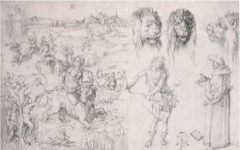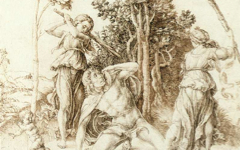Dürer’s St. Jerome in the Wilderness (1496)
Dürer’s 1496 engraving of St Jerome in the Wilderness was probably his first relatively large engraving but is, nonetheless, replete with the subtle visual illusions and metamorphic forms of a master engraver.
Isolde Lübbeke observed in 1999 that “the contours of the rocky background are filled with multiple references to man and animal”, adding that motifs like the saint’s arm and cloak are echoed in the rock and wood formations around him. She correctly sees metamorphic “faces” in the hillsides and adds, following Karl Möseneder, that Dürer “deliberately gave objects physiognomic character” throughout his oeuvre. She cites the Venetian artist Cima da Conegliano (c.1459 - c.1517) as another artist who “hid” faces in rock formations. 1
Click next thumbnail to continue
Our focus here, though, is on the little-noticed lion, the saint’s traditional attribute, which sits above the artist’s monogram, a D nestled inside an A.2 The lion has, unusually for Dürer, a most unrealistic head. Of particular note are the long strands of its mane hanging, hippy-like, on either side of its head. It is completely unlike a lion’s.
Click next thumbnail to continue

Left: Detail of Durer's St. Jerome in the Wilderness (1496)
Right: Detail of Durer's Self-portrait (1493)
Click image to enlarge.
No-one seems to have noticed that the leonine coiffure is very similar to Dürer’s own celebrated mane, represented in nearly all his self-portraits as long, loose and little-combed.
Click next thumbnail to continue

Left: Detail of Durer's St. Jerome in the Wilderness (1496)
Right: Detail of Durer's Self-portrait, inverted (1491) Erlangen
Click image to enlarge.
The lion's frown is anthropomorphic too, a facial gesture with a long history in art as a sign of thought, used moreover in a self-portrait by Dürer himself (near left).3
Click next thumbnail to continue
Lastly the lion’s near foreleg mimicks the left arm of the saint, the paw drooping slightly with the artist's hand. We can also now hazard that the lion's claws were made to mimic the action of the artist's burin (his etching needle), scratching or engraving the horizontal lines of the ground. That is why the paws seem to apply pressure ever so slightly downwards.4 We have seen something similar, the "artist" as an animal at work on his own engraving, in entries on Dürer’s Cain Killing Abel, St Jerome in his Study and, most charmingly, in Martin Schongauer's St. George and the Dragon.
See conclusion below
Lastly, just as Dürer's St. Jerome represents the artist in intellectual torment when in the wilderness, and in aesthetic contemplation when seen in his study, so the lion, his attribute, represents the artist's manual craft in both.
More Works by Dürer
On the surface this drawing by Albrecht Durer appears to be a simple portrait of Saint Dominic.

Dürer’s St. Dominic (1506)
Notes:
1. Renaissance Venice and the North: Crosscurrents in the Time of Bellini, Dürer, and Titian, eds. Bernard Aikema and Beverly Louise Brown (New York: Rizzoli) 2000, p. 270
2. This was the first time Dürer used the authorial device in its mature form. See ibid.,p. 270
3. Artists can be seen frowning in self-portraits by Mantegna, Arcimboldo, Caspar David Friedrich, Eakins, Cranach, Fragonard, Freud, Gainsborough, Pearlstein
4. See my post "Great Engravers are Dogs" (Dec. 3rd 2014) on similar use of a clawed animal by The Master of the Amsterdam Cabinet a generation before Dürer.
Original Publication Date on EPPH: 15 Sep 2011. | Updated: 0. © Simon Abrahams. Articles on this site are the copyright of Simon Abrahams. To use copyrighted material in print or other media for purposes beyond 'fair use', you must obtain permission from the copyright owner. Websites may link to this page without permission (please do) but may not reproduce the material on their own site without crediting Simon Abrahams and EPPH.





